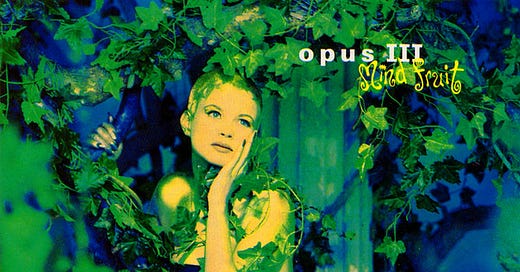Genre of the Day - Dream Trance
Album of the Day - Mind Fruit by Opus III (1992)
Is the term “dream trance” a bit redundant? My brain is still stuck wheeling through academic mechanisms a bit after sending off two final papers today. At the outset of this daily writing endeavor, I thought that I would become absolutely cracked at writing academic papers because I would be writing so frequently. I am not sure that has happened. In fact, it’s actually counterintuitively harder. I have to switch modes to produce a very clear, succinct piece of writing for a professor, when I spend most of my writing life indulging in the more flowery, ornate turns of phrasing music writing entails, under the stylistic spell of my favorite outlets like Pitchfork and the New Yorker. But now that my finals are over, I can surrender once again—today’s genre is perfect for that purpose.
Trance tends to be dreamy by nature, but dream trance ups the ante of hypnotic ambience and draws us into our sleepy visions. It makes sense, then, that dream trance registers as a subgenre early in the history of trance music, emerging in the mid-90s. Why the 1990s had such a cultural penchant for dreaminess, e.g. Mazzy Star, shoegaze, whimsical visual aesthetics—I do not know. I suppose sharp, angular, and vibrant ‘80s needed to slip back into something more subdued and romantic. Dream trance carried that mantle for dance music.
The genre emerged as a response to tragedy, a recuperative musical effort against a tragic byproduct of rave culture. In Italy in the early ‘90s, there was a rash of club goers dying after falling asleep at the wheel after going too hard all night, a failure of Europe’s lauded public transportation. DJ Robert Miles composed the dreamy, euphoric piano classical-meets-house-thumper “Children” for DJs to conclude sets with a calmer, slower dance track. Musically, dream trance focuses on melodies and rich live instrumentation from fluttering Spanish guitar by way of Ibiza trance, new age-esque piano, or organic contributions from violin or saxophone. The genre is where the spa meets the nightclub, inspiring both relaxation and invigoration. A four-on-the-floor house beat steadily thumps, its consistency lulling you the listener into a heady state.
Opus III’s Mind Fruit actually precedes “Children,” but still features all the stylistic flag bearers that make up dream trance’s ethereal fantasies. An outsized kick drum works with mystical assuredness on “It’s a Fine Day” as airy wisps of surreal samples, plinky piano, and euphoric strings raise vibrations. For all the criticism of so-called “whisper singers” by vocal purists nowadays, there’s an undeniable, artful grace to their application in dream trance, in the ephemeral vocals of “I Talk to the Wind” or the literally whispered “Sea People.” The amount of elements is minimal compared to the organized chaos of parallel subgenres like psytrance, as in songs like “Evolution Rush” built around a simple beat, upwards pad swoops, and incandescent synth riffs. Best of all, it’s your choice when you want to wake up from this dream.




